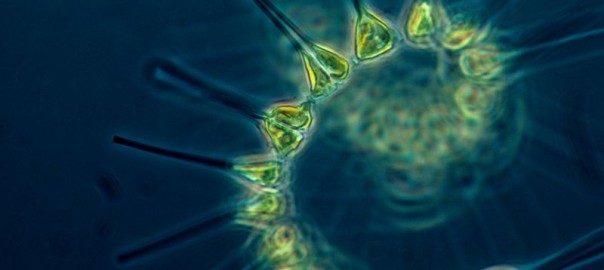by Alli Gold Roberts (MIT Joint Program on the Science and Policy of Global Change)
Read this story at MIT News
Phytoplankton — small plant-like organisms that serve as the base of the marine ecosystem — play a crucial role in maintaining the health of our oceans by consuming carbon dioxide and fueling the food web. But with a changing climate, which of these vital organisms will survive, and what impact will their demise have on fish higher up the chain?
Stephanie Dutkiewicz, a researcher with the MIT Joint Program on the Science and Policy of Global Change, and her colleagues developed a model that investigates the potential effects of climate change on phytoplankton.
“Our model is unique because we were able to include 100 different species of phytoplankton, where almost all other models include just three or four,” Dutkiewicz explains. “This diversity of species allows us to analyze the ecological effects of climate change and how species will shift, adapt, thrive or die off.”
Once Dutkiewicz and her team built their phytoplankton model, they integrated it with a 3-D model of the global ocean system that is part of the Joint Program’s Integrated Global System Model (IGSM) 2.3. This comprehensive model allows the researchers to study temperature, light and circulation in terms of both the large consequences to the ocean system as a whole and the small responses individual phytoplankton have with each other.
“This model gives a nice demonstration of the complexity of the system and how you can’t just look at one piece of it to see what’s going to happen,” Dutkiewicz says.
Dutkiewicz gives an example: If a researcher just looks at the effects from a change in temperature, they would find that phytoplankton would be more productive. But when studying the whole picture, that is not the case.
On a global scale, and in the most extreme climate scenario, Dutkiewicz finds that by the end of the century half the population of phytoplankton that existed at the beginning of the century will have disappeared and been replaced by entirely new phytoplankton species.
“There will still be phytoplankton in any part of the ocean, they’ll just be different and that is going to have impacts up the food chain,” Dutkiewicz says.
Globally ocean productivity may not change much, as different impacts of changing climate might balance each other out, Dutkiewicz’s research shows. But looking regionally paints an entirely different picture. In the tropics and higher latitudes, a decrease in the nutrients these small organisms need to survive will limit phytoplankton growth. Meanwhile, in the upper latitudes, the ocean temperatures are expected to rise, spurring phytoplankton growth.
“The take home message is, studying these complex climate interactions is not simple and trying to make it simple will give you the wrong answer,” Dutkiewicz says.
Now that Dutkiewicz has built this complex marine ecosystem model, she is planning to apply it to new research. In fact, she has already added an additional type of phytoplankton that’s a nitrogen fixer, meaning it converts nitrogen into a useable form to help feed other organisms. She plans to assess how this species has changed over time. Dutkiewicz is also assessing the impacts of iron, an important nutrient in absorbing CO2, on phytoplankton populations.
